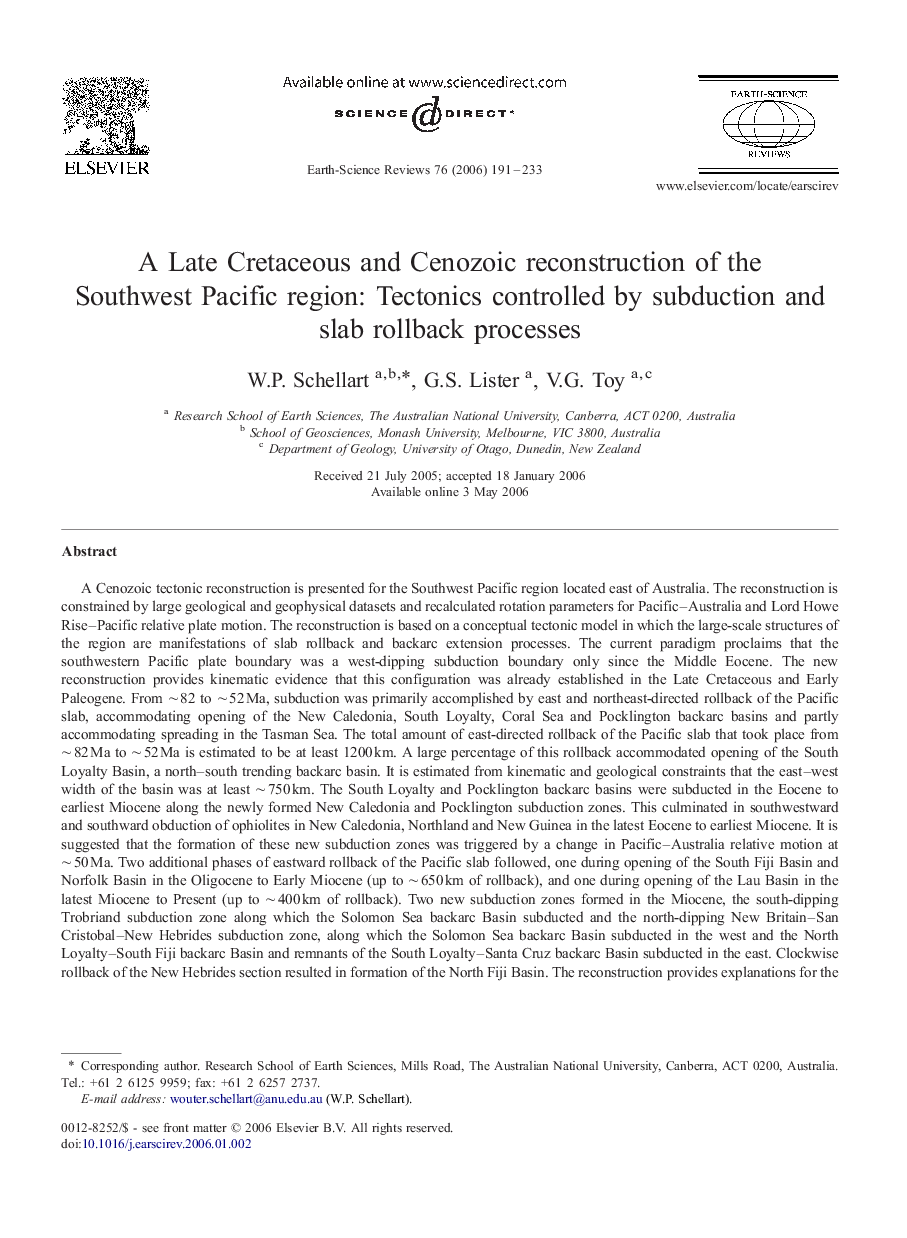| کد مقاله | کد نشریه | سال انتشار | مقاله انگلیسی | نسخه تمام متن |
|---|---|---|---|---|
| 4726495 | 1640055 | 2006 | 43 صفحه PDF | دانلود رایگان |

A Cenozoic tectonic reconstruction is presented for the Southwest Pacific region located east of Australia. The reconstruction is constrained by large geological and geophysical datasets and recalculated rotation parameters for Pacific–Australia and Lord Howe Rise–Pacific relative plate motion. The reconstruction is based on a conceptual tectonic model in which the large-scale structures of the region are manifestations of slab rollback and backarc extension processes. The current paradigm proclaims that the southwestern Pacific plate boundary was a west-dipping subduction boundary only since the Middle Eocene. The new reconstruction provides kinematic evidence that this configuration was already established in the Late Cretaceous and Early Paleogene. From ∼ 82 to ∼ 52 Ma, subduction was primarily accomplished by east and northeast-directed rollback of the Pacific slab, accommodating opening of the New Caledonia, South Loyalty, Coral Sea and Pocklington backarc basins and partly accommodating spreading in the Tasman Sea. The total amount of east-directed rollback of the Pacific slab that took place from ∼ 82 Ma to ∼ 52 Ma is estimated to be at least 1200 km. A large percentage of this rollback accommodated opening of the South Loyalty Basin, a north–south trending backarc basin. It is estimated from kinematic and geological constraints that the east–west width of the basin was at least ∼ 750 km. The South Loyalty and Pocklington backarc basins were subducted in the Eocene to earliest Miocene along the newly formed New Caledonia and Pocklington subduction zones. This culminated in southwestward and southward obduction of ophiolites in New Caledonia, Northland and New Guinea in the latest Eocene to earliest Miocene. It is suggested that the formation of these new subduction zones was triggered by a change in Pacific–Australia relative motion at ∼ 50 Ma. Two additional phases of eastward rollback of the Pacific slab followed, one during opening of the South Fiji Basin and Norfolk Basin in the Oligocene to Early Miocene (up to ∼ 650 km of rollback), and one during opening of the Lau Basin in the latest Miocene to Present (up to ∼ 400 km of rollback). Two new subduction zones formed in the Miocene, the south-dipping Trobriand subduction zone along which the Solomon Sea backarc Basin subducted and the north-dipping New Britain–San Cristobal–New Hebrides subduction zone, along which the Solomon Sea backarc Basin subducted in the west and the North Loyalty–South Fiji backarc Basin and remnants of the South Loyalty–Santa Cruz backarc Basin subducted in the east. Clockwise rollback of the New Hebrides section resulted in formation of the North Fiji Basin. The reconstruction provides explanations for the formation of new subduction zones and for the initiation and termination of opening of the marginal basins by either initiation of subduction of buoyant lithosphere, a change in plate kinematics or slab–mantle interaction.
Journal: Earth-Science Reviews - Volume 76, Issues 3–4, June 2006, Pages 191–233